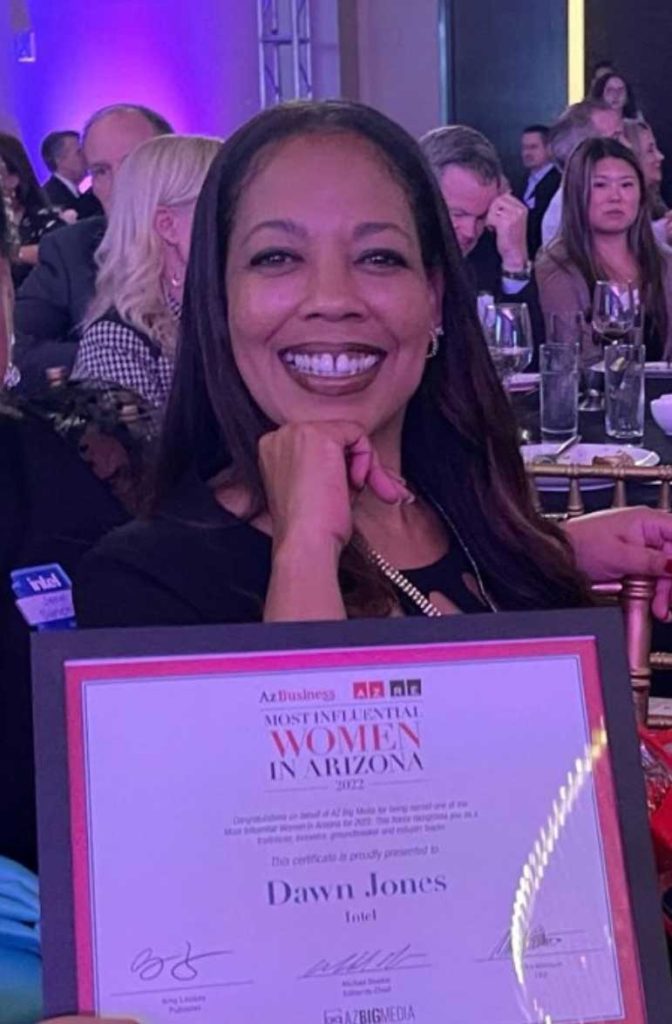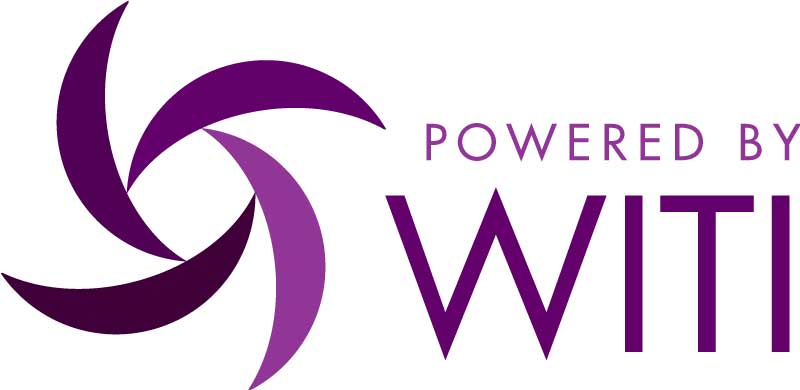Intel’s Dawn Jones on Using Your Voice and Transparency

Find the courage to use your voice, Intel executive Dawn Jones says. “If you give me a seat at the table, a voice comes with the seat,” says Jones, Intel’s Chief Diversity and Inclusion Officer and Vice President of Social Impact.
Jones joined Intel 25 years ago as an administrative assistant in its finance department, supporting the controller. She didn’t have a college degree at that point. “For years, we’ve heard of the corporate ladder,” she says. “I feel like my journey was more of a lattice. Sometimes I would take on roles and participate in teams that didn’t necessarily have a direct progression. But it was something I needed to do to build up a skill set.”
Jones leads Intel’s diversity and inclusion efforts. She tells this story to make her point about using your voice: Jones was in a meeting with Intel’s Chief Executive Officer and executive leaders. She thought she needed to speak up, she says. “I was literally having this conversation with myself, ‘Dawn, you have to say something.’”
At first, she thought she’d send an email about it after the meeting. But she reconsidered: “No, you’re in this room. If you walk out without saying anything, you’re going to think about it forever.” She asked if she could challenge the issue being discussed. This is when she realized that she was hired to give her opinion and that what she was bringing to the table added value to the discussion.
Leadership and Transparency
Jones is one of the leaders of the Alliance for Global Inclusion, a partnership with Dell, NTT Data, and other companies formed in 2020 to help accelerate change in diversity, equity, and inclusion in the tech industry. “Transparency is key to driving progress,” Jones says. “When you are transparent with your data, you’re holding yourself accountable.”

That’s not always easy in a competitive and fast-changing field, she says. “The difficulty in being transparent is that sometimes the data is not great.” But Jones is a strong believer in being public with the data and collaborating with other industry leaders. It can be a catalyst for effecting change, she says.
“For us at Intel, it is important to show that we are taking a leadership role and being as transparent as we can. We continue to collaborate and encourage industry partners to be transparent when they’re sharing their data: it sets up opportunities to do something better,” Jones says.
“It’s increasingly becoming important, not only to the communities in which we live but for investors. There’s increased interest and regulation around what we call corporate social responsibility, specifically in environmental and sustainability spaces.”
Intel’s Diversity, Equity, and Inclusion Goals
Intel has “aggressive goals focused on 2030” for diversity, equity, and inclusion in the company’s RISE (Responsible, Inclusive, Sustainable, and Enabling) framework, Jones says. One goal of its 2030 framework is for Intel to double the number of women and underrepresented minorities in senior leadership roles. Intel, which has approximately 120,000 employees globally, defines underrepresented minorities as African American, Hispanic, and Native American.
Another goal is for women to hold 40 percent of Intel’s technical roles, Jones says.
That goal will be challenging, she says. “Market availability is about 26 percent at best. But we feel like if you don’t establish a bold goal people will stop paying attention.”
Intel’s 2019-2020 workforce data show some key findings:
- In its global workforce, women’s representation improved by .4 percentage points from 27.4 percent to 27.8 percent. For women in executive-level positions, there was a .8 percentage point increase from 20.3 percent to 21.1 percent.
- Overall, underrepresented minority populations improved by .4 percentage points from 15.8 percent to 16.2 percent, which was driven mostly by Latinx representation. African American representation was flat at 4.9 percent.
The Glass Ceiling and Change
Intel is a platinum sponsor of Women in Technology’s Glass Ceiling Report 2.0, which will be published in fall 2022. The idea behind the report is to bring together leaders in the technology sector to understand and design a more diverse and inclusive workplace.

A bipartisan federal commission in 1995 studying discrimination in the workplace found that women and minorities faced a variety of barriers to advancing to top management levels in corporations.
Reports like the Glass Ceiling Report 2.0 are “critical,” Jones says. “I’m hoping the study gives us insight into a robust data set…We want to accelerate progress through the use of this data. Is it still a glass ceiling the way it was 30 years ago? Has the glass been tempered?”
Jones has seen some key findings in the report. “It was interesting to see the challenges that women faced 20 years ago are still some of the same challenges that women continue to face. But it was also encouraging to see there has been progress.”
In a hybrid workplace with the possibility that remote work might become standard in companies, Jones raises some critical questions:
- How do you address the difference in perception of managers for those employees that are onsite or working remotely?
- How do you motivate employees and provide a sense of belonging when there is no in-person interaction?
Key Points in Jones’ Journey
Looking back at her career, Jones says it’s essential to “own your own destiny. … I would say throughout my 25 years, it has been important for me to be in the driver’s seat.” When she joined Intel, Jones was a single mother and hadn’t finished her bachelor’s degree. “I asked my leader at the time if she would pay for me to go back to school and she agreed…My main goal was to send my daughters to college eventually,” she says.
“For a year and a half, I went back to school full-time, I worked full-time, and I was a full-time Mom.” When Jones joined another department – she spent many years in Intel’s public affairs department – she decided it would be wise to get a master’s degree. The manager of that department, also a woman, became her second mentor and sponsor, she says.
Jones graduated from Arizona State University with a degree in Broadcast Journalism.
She earned a Master of Science in Communications Management from Syracuse University.
What to Look for in Mentors and Sponsors
“A mentor really helps you with that day-to-day engagement – I’m struggling with this, how do I navigate the politics of that, I want to bounce some ideas off you.” A sponsor is widely known to be someone who can advocate on your behalf in a room you’re not in.
“I think sponsorship is critically important, especially for women and people of color where we otherwise might not be in the room,” she says. This is a big reason for women to have male and female sponsors. “If you’re in tech where there are potentially all men in a room, you need to make sure your work can be brought forward, regardless of who is in the room at the time.”
In addition, Jones advises employees to seek out more than one sponsor. “If you put all your efforts with one sponsor and they retire, you have to start the whole process over again.”
Jones’ top three tips to succeed in the tech industry?
- Be sure you have a seat at the table.
- Listen and leverage your voice.
- Do one thing differently. It could be starting a scholarship program or getting your senior manager’s support for a new program.
Through processing her thoughts and gathering the courage to use her voice in the meeting with Intel’s CEO, Jones said she learned a valuable lesson: “I had to be vulnerable.”
People have to drive their career paths. “I don’t care if it’s a new person, a mentor, a sponsor, be direct with your leader when you’re asking about your compensation and your ability to grow and progress…,” she says. “They’re not going to magically come out and say, ‘You need to be promoted for grades above where you are, and here’s a whole bunch of money.’ You have to sit down and say, ‘I’m interested in being promoted. This is why, these are the results, and I deserve it.’”

